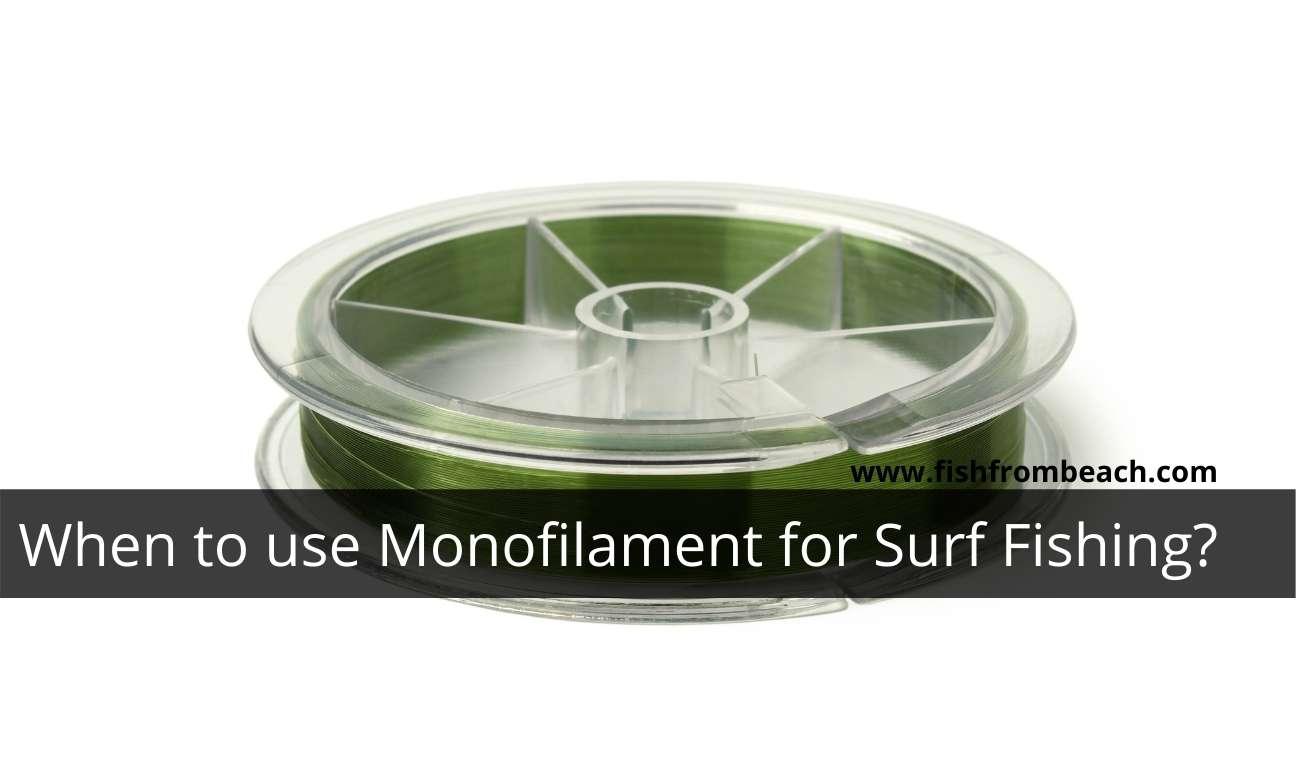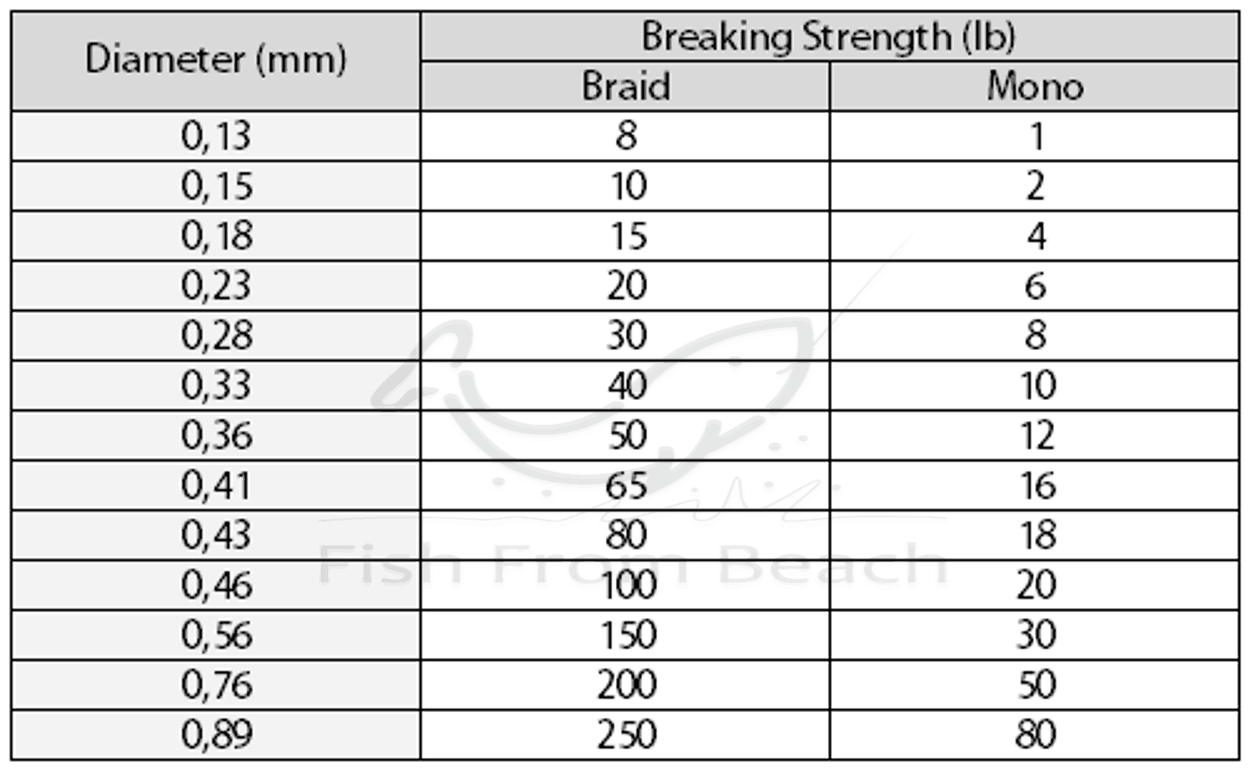
Monofilament is a great line for surf fishing.
Since its first apparition in the 1950s, nylon monofilaments have provided fishermen with everything they need to land more and better fish from shore: ease of use, profitability, low visibility underwater, elasticity, stronger knotting, etc.
However, in the last decades, braided lines have also well developed and succeeded to create a loyal following among surf anglers.
Today, it is safe to say that the market is competitively split between braid and monofilament, which leads anglers to wonder if monofilament is the best choice for surf fishing and when is the right time to use it off the beach.
That’s what we’ll discuss today.
In this article, we will talk about the pros and cons of monofilament, how it is different from braid? When should you use it for surf fishing? and when should you consider the braid instead?
So without further ado, let’s dive in.
Too Long; Didn’t Read.
As a general rule, monofilament should be used for fishing in calm surf conditions and for targeting small and medium-sized fish. Additionally, the abrasion resistance of monofilament makes it the way to go for rocky shores and fish with sharp teeth.
When to use monofilament for surf fishing?
When still learning
Monofilament is stretchy and therefore helps to handle pressure more easily.
This can be an enormous advantage for beginners who are still learning how to turn fish and how to react in pressure moments.
In other words, the stretching capacity of monofilament serves as a safety cushion when the line goes tense and therefore allows novice anglers to avoid frequent (and annoying) cut-offs.
Braid does not stretch and therefore gives a tight error margin. I mean, when using braid and things get tense, you can only rely on your experience to handle the pressure. Braid will do nothing to save you and therefore should not be the way to go if you are just starting out.
In your early years as a surf angler, it’s better to stick to monofilament and exploit the advantage it offers you to make mistakes without getting punished.
Worth noting that the stretching quality of monofilament also protects your rod and reel. Also, you will generally be more comfortable on the shoreline and suffer less fatigue and back pain if you use monofilament.
This is because, during tense moments, most of the pressure will be on the stretchy line. Conversely, when using braid, the pressure will be dispatched between the line, rod, reel, and your back.
When fishing calm surf conditions
Monofilament is a poor choice during heavy currents and choppy surf conditions.
Baitfish only hold where they feel safe to hide and eat. In turn, predatory fish hold where they have easy access to those baitfish.
As a result, most species, big or small, tend to concentrate in particular spots and leave the rest of the surf zone empty.
I mean, while the small species prefer to stay near the shelter and only feed on the safest nutrients without venturing for distant food, larger predators also lurk where prey hold and wait for unwary ones to pass by.
Now, what does this imply? It simply implies that when surf fishing, the spot you target is a determinant factor for your success.
In other words, you need to be in total control of where you deploy the bait and force it to remain there the entire cast. Otherwise, you may end up in a deserted area where there is no fish.
That’s why you should avoid using monofilament in unstable surfs. Mono is thick and therefore less stable when the water is moving.
Let me elaborate.
As a general rule, monofilament is thicker than braid.
The table below compares the thickness of both mono and braid for each breaking strength (pound test).

As you can see, for a given pound test, monofilament is always thicker than braid. For instance, the thickness of a 10 lb test line is about 0,15 with braid and 0,33 mm with mono.
Now, how this difference impacts fishing? Well, in simple words, the thicker the line, the more it is affected by the current, water movement, tidal changes, wave action, wind, etc.
Choppy weather is, therefore, likely to make monofilament unstable in the surf zone and may take your terminal tackle to areas where no fish hold.
In this scenario, you will be forced to use heavier sinkers to gain more stability, and this can be counterproductive. Why? Because, the higher your casting weight, the weaker the sensitivity and feedback you receive from the other end of the line, and as a result, the harder it is to detect bites and turn fish.
Read more about surf fishing weights.
Calm surfs, on the other hand, do not run this risk and your mono line is likely to remain where you want it to be, without the need to use too much weight.
When targeting small and medium-sized fish
The table we just discussed also points out to the face that monofilament is generally weaker than braid. I mean, in order to have a strong monofilament line, you must pick a high diameter, which, as we just discussed, can be ineffective and prevent your bait from staying where the interesting things happen.
Therefore, and as a general rule, monofilament is not optimal for heavy fish. The pound test will simply not be enough to turn monsters like sharks, albacore, or bull redfish.
Monofilament is more suitable for small and medium-sized fish like pompano, bluefish, flounder, snappers, bream, etc.
Such species rarely exceed 20-25 pounds and therefore do not require a high pound test (and thick diameter) in order to meet them.
Now let me reassure you that most species living in the surf zone fall within the second category. So size-wise, monofilament is just fine for surf fishing and, most of the time, will not pose any problem.
With that in mind, if you know that large fish hold within your casting range, make sure to pick a high pound test or use braid instead.
When fishing sharp structures
The abrasion resistance of monofilament makes it suitable for rocky shores and rough grounds.
The cover and feeding opportunities these structures provide attract large amounts of different species, which make them very rewarding for surf anglers. But at the same time, however, these structures can also be unsafe for your terminal tackle.
Generally speaking, the snagging rate is higher when you cast into the rocks and your hooks are likely to tangle more often in mixed seabeds.
This can cost you a load of lures, sinkers, and hooks, and may give you a hard time every time you want to reel in the line.
Not only that, but fighting fish is just more challenging in the rocks. When they feel trapped, fish simply start going up and down and navigating between the wrecks and rock piles, rubbing your line against the abrasive surfaces and thus putting them at a higher risk to snap.
That’s where monofilament comes into play.
Mono responds better to abrasion and therefore performs betters in such conditions. Conversely, braid is a poor abrasion resistant and will just not make it down there.
With that in mind, the type of the line is not the only thing to consider before rock fishing.
I mean, yes, monofilament is good for abrasion, but it will not prevent cut-offs if your technique, rig, hook, and leader are not good.
Here is an article that will help you choose the right tackle if you want to fish rocky shores.
When targeting sharp-toothed fish
The abrasion resistance of monofilament also helps to handle fish with sharp jaws.
When targeting species like the snapper, mackerel, and bluefish, you need to pay extra attention to the strength of your line. Why? Well, simply because these species have a sharp set of teeth and therefore risk snapping your line if they strike the bait.
These species are also more difficult to land to shore because during the fight, they can at any moment cut the line and run with the food.
That’s why monofilament is the way to go for these species. Compared to braid, mono is likely to better survive the sharp teeth of these fish.
Some recommended monofilament lines for surf fishing (*)
Note (*): If you make a purchase through links from this website, we may get a small share of the sale from Amazon or other similar affiliate programs.
Surf Fishing Survey
Help us provide you with better content by answering simple questions about your surf fishing experience and knowledge.
We will put the collected responses together and turn them into valuable information that will help you catch more fish from shore 😉
Note: No personal information will be collected with your answer.

